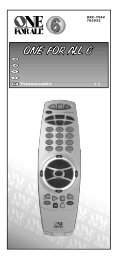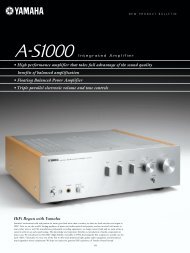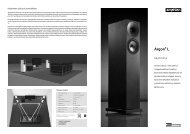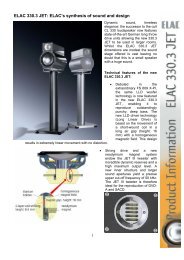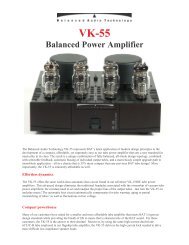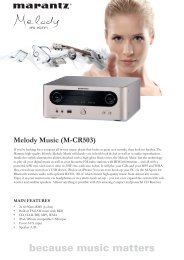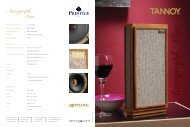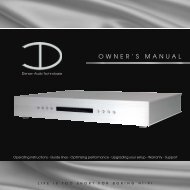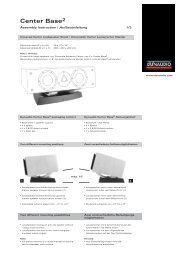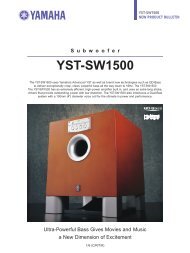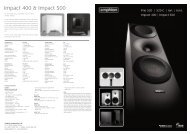Manual - Tannoy
Manual - Tannoy
Manual - Tannoy
You also want an ePaper? Increase the reach of your titles
YUMPU automatically turns print PDFs into web optimized ePapers that Google loves.
<strong>Manual</strong><br />
1
CONTENTS<br />
4 <strong>Tannoy</strong> - A short history<br />
8 Introduction to the Kingdom Royal<br />
10 <strong>Tannoy</strong> Dual Concentric TM drive unit<br />
14 Supertweeter TM<br />
16 Bass driver<br />
18 Crossover<br />
22 Enclosure<br />
24 Unpacking instructions<br />
28 Positioning<br />
30 Amplifier choice<br />
32 Cable choice<br />
34 Amplifier connections<br />
36 Single wire connections<br />
40 Bi-wiring theory<br />
42 Bi-wiring connections<br />
44 Bi-amping<br />
46 Grille removal<br />
48 Loudspeaker system adjustment<br />
50 Running in<br />
52 Note on auditory perception<br />
54 Care of cabinet<br />
56 Fault finding<br />
58 Warranty<br />
60 Specification<br />
3
TANNOY - A SHORT HISTORY<br />
In the early days of broadcasting, radio<br />
sets needed both low and high voltage<br />
DC power that had to be supplied by<br />
batteries. The lead acid batteries used<br />
in the radio sets of the time needed<br />
regular recharging.<br />
In London, in 1926, Guy R. Fountain<br />
perfected a new type of electrical<br />
rectifier with the aim of designing a<br />
charger more suitable for use in the<br />
house. His rectifier consisted of two<br />
dissimilar metals held in a special<br />
electrolyte solution. One metal was<br />
Tantalum and the other an alloy of<br />
Lead. So successful was this invention<br />
that Guy Fountain founded a British<br />
Company called <strong>Tannoy</strong> (a contraction<br />
of the words ‘Tantalum’ and ‘Alloy’).<br />
<strong>Tannoy</strong> soon became internationally<br />
known and highly regarded in all<br />
aspects of sound reproduction.<br />
Moving coil loudspeakers with DC<br />
energised magnets began <strong>Tannoy</strong>’s<br />
continued success in the field of<br />
loudspeaker technology. A discrete<br />
two-way loudspeaker system followed<br />
in 1933 and shortly after a range of<br />
microphones and loudspeakers capable<br />
of high power handling.<br />
<strong>Tannoy</strong> has always been at the forefront<br />
of the communications revolution,<br />
developing its own equipment and<br />
production technology. The company<br />
built a fund of knowledge and experience<br />
that has proved invaluable in the<br />
development of loudspeakers for a truly<br />
wide range of applications. The now<br />
famous <strong>Tannoy</strong> Dual Concentric<br />
principle was created and developed<br />
under Guy Fountain’s direction around<br />
1950. It is highly regarded by music<br />
enthusiasts, and recording and broadcast<br />
studios because of its unique properties<br />
in faithfully reproducing sound to a very<br />
high quality standard.<br />
4
Guy Fountain retired from the company<br />
in 1974, but the <strong>Tannoy</strong> company<br />
continues his philosophy dedicated<br />
to the accurate and realistic reproduction<br />
of music for both enthusiasts and<br />
professionals around the world.<br />
<strong>Tannoy</strong> is now part of the TC Group,<br />
whose goal is to design, produce and<br />
distribute the best engineered, most<br />
recognised and respected brands of<br />
high performance audio products in<br />
the world.<br />
The <strong>Tannoy</strong> Research and Development<br />
unit has further refined the innovative<br />
Dual Concentric principle. Using the<br />
latest design and material technologies,<br />
with sophisticated circuit techniques in<br />
crossover design, <strong>Tannoy</strong> has produced<br />
a loudspeaker system with superb<br />
reproductive capabilities and<br />
exceptionally wide dynamic range.<br />
7
INTRODUCTION TO<br />
THE KINGDOM ROYAL<br />
The Kingdom Royal is a statement in<br />
engineering excellence, hand crafted<br />
to exacting standards and setting a<br />
new reference for musical performance.<br />
Distilling 80 years of <strong>Tannoy</strong> expertise<br />
into a new flagship loudspeaker<br />
of unrivalled accuracy, musical<br />
coherence and dynamic range.<br />
Four years of extensive research,<br />
cutting edge technologies, new<br />
processes, and extensive design<br />
detailing have resulted in the most<br />
revealing and musically articulate<br />
loudspeaker <strong>Tannoy</strong> has ever built.<br />
8
TANNOY DUAL CONCENTRIC TM<br />
DRIVE UNIT<br />
One of the unique advantages of the<br />
<strong>Tannoy</strong> Dual Concentric principle is<br />
that the low and high frequency sound<br />
radiation is generated on the same axis.<br />
The high frequency unit is mounted<br />
behind, and concentrically with, the low<br />
frequency unit. High frequency sound<br />
radiates from the centre of the low<br />
frequency unit through a carefully<br />
designed high frequency exponential<br />
horn. Low and high frequencies are<br />
therefore fully integrated at source.<br />
It is this feature that gives the Dual<br />
Concentric driver such unique sound<br />
reproduction qualities.<br />
There are other significant benefits.<br />
The high frequency unit does not<br />
obstruct the low frequency unit in any<br />
way (a unique feature when compared<br />
with other so called coaxial systems).<br />
Polar dispersion of sound is symmetrical<br />
in both horizontal and vertical planes.<br />
By careful crossover network design<br />
the virtual acoustic sources of the high<br />
and low frequency units can be made<br />
to occupy the same point on the axis.<br />
Therefore the total sound appears to<br />
emanate from a single point source<br />
located slightly behind the drive unit.<br />
This means that a full and accurate<br />
stereo image can be recreated by the<br />
loudspeakers when fed from a high<br />
quality stereo source.<br />
The Kingdom Royal has an all-new state<br />
of the art 12 inch Dual Concentric TM<br />
driver. The outer bass/ midrange driver<br />
combines a revolutionary low mass,<br />
ultra-rigid multi-fibre cone and precision<br />
edge-wound voice coil with a massive<br />
ferrite motor system for breathtaking<br />
transient response across the upper<br />
bass to lower midrange spectrum.<br />
ENGINEERING<br />
11
Its hard-edge roll surround has a very<br />
low memory effect further improving<br />
articulation in the mid and upper<br />
bass and is also damped and shaped<br />
correctly to terminate the moving<br />
cone and provide optimum compliance<br />
and linearity at large excursions.<br />
This outer driver crosses over to the<br />
high frequency unit at an exceptionally<br />
low 700Hz to ensure key vocal ranges<br />
are handled by the new tweeter.<br />
accuracy combined with exceptional<br />
dynamic abilities. After bonding to the<br />
copper-clad aluminium voice coil, the<br />
assemblies are deep cryogenically<br />
treated. This relieves residual stresses<br />
in the microstructure of the dome and<br />
reduces crystal boundary imperfections<br />
in the voice coil for greater naturalness<br />
and emotional communication of<br />
the music.<br />
This HF drive unit is one of <strong>Tannoy</strong>’s<br />
most radical driver designs to date.<br />
It couples a 3 inch heat treated<br />
aluminium alloy dome with a 1.5kg<br />
ferrite motor to create an extremely<br />
efficient horn-loaded compression<br />
driver, to give reference standard tonal<br />
12
SUPERTWEETER TM<br />
At 17kHz the Dual Concentric TM HF<br />
unit crosses over to the latest evolution<br />
<strong>Tannoy</strong> SuperTweeter TM . Again many<br />
engineering hours were spent selecting<br />
the right material for the Kingdom<br />
Royal SuperTweeter TM dome, with a<br />
magnesium alloy finally being chosen<br />
for its lack of colouration, coherence<br />
and even extension out to 61kHz. Each<br />
dome is vapour coated with a thin<br />
ceramic layer for optimum rigidity and<br />
damping, before being carefully plasma<br />
treated by hand and bonded to the<br />
voice coil. This revolutionary plasma<br />
technique increases the surface<br />
energy of the dome to give greater<br />
coupling to the voice coil and ensure<br />
greater consistency. Combined with a<br />
neodymium motor and rear damping<br />
cavity, the new SuperTweeter TM offers<br />
outstanding linearity and accuracy,<br />
alongside higher sensitivity and wider<br />
bandwidth than the previous generation<br />
titanium SuperTweeter TM .<br />
For ultimate fidelity the enthusiast<br />
will appreciate the slight improvement<br />
in clarity and detail that is achieved by<br />
removing the SuperTweeter TM grilles<br />
during listening.<br />
The Supertweeter TM grille is a friction fit<br />
part which locks onto the gold trim via<br />
four discrete slots. Carefully remove by<br />
pulling the wire mesh towards you.<br />
It is essential that the SuperTweeter TM<br />
diaphragm is not touched, as damage<br />
will destroy its performance and require<br />
specialist repair by your <strong>Tannoy</strong> dealer.<br />
Any such damage will not be<br />
covered under warranty.<br />
15
BASS DRIVER<br />
To deliver accurate and extended<br />
low frequencies, the Kingdom Royal<br />
features a 15in multi-fibre bass driver<br />
with massive ferrite motor system and<br />
underhung voice coil. In an underhung<br />
configuration the top plate is extended<br />
to ensure the voice-coil remains<br />
completely within the flux of the magnet<br />
over its entire range of motion.<br />
While underhung driver topology is<br />
expensive to implement, the result<br />
is constant electromotive force on<br />
the voice coil leading to significantly<br />
lower distortion than traditional driver<br />
designs and improved motor cooling.<br />
Extensively tuned by <strong>Tannoy</strong>’s most<br />
experienced electro-acoustic engineers,<br />
the bass driver produces prodigious<br />
low frequency extension with fluid and<br />
articulate bass delivery through to the<br />
crossover point with the DC driver. The<br />
cabinet has been engineered to offer<br />
ideal damping and suspension characteristics<br />
while the rear port is tuned to<br />
an extremely low 15Hz in order to retain<br />
the Kingdom Royal’s ultra-fast dynamics<br />
into the sub-bass range.<br />
16
CROSSOVER<br />
The Kingdom Royal necessitated the<br />
most sophisticated crossover <strong>Tannoy</strong><br />
has ever designed, splitting the low<br />
frequency and high frequency sections<br />
into individual assemblies, to avoid any<br />
electrical interaction between the two.<br />
The entire crossover is decoupled from<br />
the cabinet base using an innovative<br />
free-floating isolation system, with rubber<br />
suspension turrets. Both upper and<br />
lower HF and LF boards are hard-wired<br />
(i.e. not a printed circuit board) using<br />
silverloaded solder and six nines<br />
PCOCC TM copper (99.9999% pure<br />
copper) cable.<br />
After extensive testing 99.997% purity<br />
single strand silver cable was chosen<br />
for the SuperTweeter TM circuit for its<br />
exceptional top end transparency.<br />
<strong>Tannoy</strong>’s DMT TM (Differential Materials<br />
Technology) compound is used to seat<br />
components, further improving<br />
damping and resulting in greater<br />
naturalness and pin point imaging.<br />
Once assembled the entire crossover<br />
undergoes full deep cryogenic<br />
treatment to relive component and<br />
conductor stresses at crystal level.<br />
While cryogenic treatment is a costly<br />
process for such a large assembly, the<br />
resulting benefit in terms of musical<br />
cohesion and smoothness make it an<br />
essential part of the Kingdom Royal’s<br />
natural sound.<br />
19
At crossover component level, the<br />
component choice to match the<br />
new Kingdom Royal drivers was a<br />
critical design concern. Many brands<br />
and types of component were<br />
auditioned and rejected before the<br />
final configuration. Each crossover<br />
uses the very latest ICW ClarityCap TM<br />
MR polypropylene capacitors as these<br />
were found to have the lowest internal<br />
resonance and better self damping<br />
than any other capacitor on the market.<br />
Low loss laminated core inductors are<br />
used throughout and non-inductive<br />
heat-sink mounted thick film resistors<br />
were chosen for their micro-dynamic<br />
capabilities and thermal stability.<br />
Impedance matching the Dual<br />
Concentric TM HF unit was another<br />
area of concern, with the very best<br />
acoustic results coming from a custombuilt<br />
autotransformer rather than<br />
traditional resistive circuit, in order to<br />
maintain damping. Adjustments<br />
for the Dual Concentric TM Tweeter<br />
and SuperTweeter TM energy levels<br />
are available using a new low-loss<br />
switching panel mounted on the<br />
front baffle.<br />
On the rear panel very high quality<br />
WBT TM binding posts are configured<br />
in <strong>Tannoy</strong>’s unique five-terminal<br />
arrangement that affords bi-wiring and<br />
bi-amping as well as direct grounding<br />
(via the fifth terminal) for the chassis of<br />
the main drivers. The grounding of the<br />
chassis helps to reduce radio frequency<br />
interference providing a smoother<br />
sound with improvements in detail<br />
and transparency.<br />
20
ENCLOSURE<br />
The Kingdom Royal cabinet derives<br />
its striking visual form from its no<br />
compromise function. The massive<br />
curve-sided cabinet is constructed from<br />
machined high density fibreboard<br />
laminated with birch plywood sourced<br />
from cooler, slow growing regions of<br />
the world for its superior density and<br />
acoustic properties. Built with both<br />
vertically and horizontally laminated<br />
panels and braced with <strong>Tannoy</strong>’s DMT TM<br />
technology, the cabinet is incredibly<br />
rigid despite the large panel areas.<br />
This engineering technique has afforded<br />
a very stiff enclosure with high internal<br />
volume that allows the deepest bass<br />
notes to be accurately reproduced.<br />
The sealed SuperTweeter TM enclosure<br />
is precision milled from a laminate<br />
of medium density fibreboard and<br />
acoustically separated from the main<br />
cabinet enclosure. Tuned and damped<br />
by both measurement and audition,<br />
its performance is further enhanced<br />
by a soft dispersion panel set in front<br />
of the housing. After trialling a number<br />
of synthetic and natural materials, soft<br />
Italian leather was selected as being<br />
the most effective.<br />
23
UNPACKING<br />
CAUTION:<br />
Each Kingdom Royal loudspeaker is<br />
very heavy, weighing 120kg (265lbs).<br />
Do not attempt to unpack single<br />
handed. We recommend that five<br />
people are present to unpack the<br />
product for safety reasons. Examine all<br />
pieces of packing material and inspect<br />
the carton for signs of external damage.<br />
If there is evidence of excessive damage<br />
to the packaging and resulting damage<br />
to the loudspeaker please inform the<br />
carrier and the supplier immediately.<br />
Always keep the packaging in such<br />
circumstances for subsequent<br />
examination. <strong>Tannoy</strong> strongly<br />
suggests that you store the complete<br />
packaging set for possible future use.<br />
24
To avoid damage to the finely crafted<br />
cabinet, please adhere to the following<br />
method:<br />
1. Open the carton top and remove<br />
the accessory box and foam cap.<br />
Please note that there is only<br />
one accessory box supplied with<br />
each pair of loudspeakers.<br />
2. Remove the 4 pieces of edge<br />
guard then lift off the cardboard<br />
packaging.<br />
3. Pull the straps clear of the bottom<br />
foam cap. Split the foam in<br />
the position shown and unwrap<br />
from product. Do not pull the<br />
foam up over the product as<br />
this risks scratching the cabinet.<br />
4. Using four people, lift the product<br />
using the straps provided.<br />
5. The fifth person should pull the<br />
pallet out from under the cabinet.<br />
6. The cabinet can then be placed<br />
slowly back on the ground.<br />
7. Gently manoeuvre the product off<br />
the rear of the lifting board. As the<br />
back edge of the cabinet is<br />
on the floor, tip the product<br />
slightly on its back edge and pull the<br />
lifting board clear to avoid damage<br />
to the bottom of the cabinet.<br />
8. Position cabinet at roughly the<br />
intended listening position.<br />
The attached castors will help<br />
considerably with this.<br />
To repack, please follow these<br />
instructions in reverse order.<br />
IMPORTANT: It is the responsibility<br />
of those involved to safely unpack the<br />
product, and <strong>Tannoy</strong> will not be held<br />
liable for any resulting loss, damage<br />
or injury.<br />
27
POSITIONING<br />
Place the loudspeakers with their rear<br />
panels approximately 1m from the rear<br />
wall. Remember that the proximity<br />
of the loudspeakers to walls and<br />
corners will affect the sound. Some<br />
experimentation will probably be<br />
needed to fine tune the stereo<br />
image depth and low frequency<br />
sound quality. Stereo image<br />
separation and depth will be<br />
improved by toeing-in the cabinets<br />
towards the listening position. The axes<br />
of the cabinets can even intersect at a<br />
point slightly in front of the listening<br />
position. Close-to-wall positions and<br />
room corners more so, have the effect<br />
of increasing very low frequency sound<br />
energy. Reflective adjacent walls may<br />
upset the stereo image by causing<br />
unwanted reflections.<br />
When the optimum position for the<br />
loudspeakers has been determined,<br />
position the three metal cups provided<br />
in the accessories pack, so that they sit<br />
under the three support cones, on the<br />
underside of the loudspeaker. These are<br />
positioned two at the front and one at<br />
the rear. This will give maximum<br />
stability, and enable your loudspeakers<br />
to provide their full dynamics and<br />
resolution of detail.<br />
WARNING: This operation should be<br />
carried out by two people, to avoid<br />
the risk of personal injury, should the<br />
speaker slip or fall.<br />
28
AMPLIFIER CHOICE<br />
Consult the product specification pages<br />
within this manual as this clearly shows<br />
the acceptable power range for amplifier<br />
matching to your speakers. The high<br />
peak power handling of <strong>Tannoy</strong><br />
loudspeakers permits responsible<br />
use with more powerful amplifiers -<br />
please read the Warranty.<br />
As with all loudspeaker systems, the<br />
power handling is a function of voice<br />
coil thermal capacity. Care should<br />
be taken to avoid overdriving any<br />
amplifier, as this will cause output<br />
overload resulting in ‘clipping’ or<br />
distortion within the output signal.<br />
This may cause damage to the<br />
speakers over an extended period.<br />
Generally an amplifier of higher power<br />
that is running hard, but free of<br />
distortion, is safer than a lower power<br />
amplifier continually clipping. Remember<br />
also that a high powered amplifier<br />
running at less than 90% of output<br />
power generally sounds a great deal<br />
better than a lower powered example<br />
struggling to achieve 100%. An amplifier<br />
with insufficient drive capability will not<br />
allow the full performance of the<br />
loudspeakers to be realised.<br />
Some customers however may wish to<br />
use low powered valve (tube) amplifiers,<br />
such as single ended triode designs,<br />
with outputs lower than our<br />
recommended minimum amplifier<br />
power. The use of such amplifiers will<br />
not cause damage to the loudspeaker,<br />
but dynamic range and maximum<br />
volume will be limited, especially in<br />
larger rooms.<br />
31
CABLE CHOICE<br />
Always use the best quality of cable<br />
available within your budget. High<br />
quality audio signals passing from the<br />
amplifier to the loudspeaker are unusual<br />
in their demands on the cable. Wide<br />
dynamic range and frequency<br />
bandwidth information has to<br />
coexist with the ability to transmit<br />
peak currents of at least 10 amps,<br />
without incurring any loss or signal<br />
impairment. This is why the sound<br />
quality of the information reproduced<br />
by the loudspeakers is so dependent<br />
on the physical properties of the cables<br />
connecting them to the amplifier.<br />
We would recommend that you always<br />
keep the cable runs the same length<br />
for each speaker. Remember that cable<br />
construction can affect the sound<br />
quality so be prepared to experiment<br />
to find a cable that suits your listening<br />
preference and audio system.<br />
32
fig. 1<br />
HIGH FREQUENCY<br />
NEGATIVE(-) TERMINAL<br />
HIGH FREQUENCY<br />
POSITIVE(+) TERMINAL<br />
LOW FREQUENCY<br />
NEGATIVE(-) TERMINAL<br />
'EARTH' OR 'GROUND' TERMINAL<br />
LOW FREQUENCY<br />
POSITIVE(+) TERMINAL<br />
TERMINATION PANEL<br />
34
AMPLIFIER CONNECTIONS<br />
Referring to the terminal panel diagram<br />
(see fig. 1), both low and high frequency<br />
sections of the loudspeaker are<br />
provided with their own set of input<br />
terminals. This enables operation in<br />
either single wire, bi-wire or bi-amp<br />
configuration. For optimum performance,<br />
the earth connection on the terminal<br />
panel should be connected to the<br />
amplifier chassis earth or other ground<br />
point. This screening effect can give<br />
an improvement in detail clarity,<br />
depending on the amplifier used.<br />
Optimum results are achieved using<br />
a screened loudspeaker cable designed<br />
for such a system.<br />
35
SINGLE WIRE CONNECTIONS<br />
Connect the loudspeakers to the<br />
amplifier using a high quality cable.<br />
Your dealer will be able to make<br />
recommendations. The terminals will<br />
accept either spade or banana plugs.<br />
Fit the link wires from the accessories<br />
box, (see fig. 2).<br />
Arrange the connections so that the<br />
right hand amplifier channel terminals<br />
are connected to the right hand<br />
loudspeaker as viewed from the<br />
listening position.<br />
Correct polarity of the connections<br />
between the amplifier and speakers is<br />
essential. The positive terminal on the<br />
amplifier left channel, marked + (plus)<br />
or coloured red, must be connected to<br />
the positive terminal on the left<br />
loudspeaker. The negative terminal<br />
on the amplifier left channel, marked<br />
- (minus) or coloured black, must be<br />
connected to the negative terminal on<br />
the left loudspeaker.<br />
Repeat this connection for the right<br />
speaker. Good quality cables and tight,<br />
well-made connections are necessary to<br />
eliminate resistive losses and maintain<br />
the correct damping of the loudspeaker<br />
by the amplifier.<br />
36
+ - + -<br />
fig. 2<br />
TO RIGHT<br />
SPEAKER<br />
+ - + -<br />
L<br />
R<br />
POWER AMPLIFIER<br />
LINK WIRES IN PLACE<br />
SINGLE WIRE CONNECTION<br />
TO RIGHT<br />
SPEAKER<br />
37
If the cables and connections have been<br />
made correctly as described above the<br />
loudspeakers will be automatically in<br />
phase with each other. However if<br />
phasing is felt to be incorrect (for<br />
example, diffuse stereo image, lack<br />
of bass) then apply the following test:<br />
Place the loudspeakers side by side and<br />
play a monophonic signal from the<br />
amplifier, choosing the programme<br />
material with a strong bass content.<br />
If phasing is correct bass will be full<br />
and rich. If incorrect there will be very<br />
little bass due to cancellation effects.<br />
Incorrect phasing can be remedied by<br />
reversing the connecting leads to one<br />
loudspeaker (at either the amplifier or<br />
the loudspeaker terminals but not both).<br />
Note: Be certain to ensure that the<br />
amplifier is switched off when<br />
connecting or disconnecting<br />
loudspeaker leads. Also accidentally<br />
shorting the loudspeaker leads together<br />
can damage some amplifiers. Such<br />
damage is outside warranty provisions.<br />
39
BI-WIRING THEORY<br />
Loudspeakers need power signals to<br />
produce acoustic energy when<br />
reproducing music. The range of<br />
electrical currents passing down the<br />
cable from the amplifier to the<br />
loudspeaker is very wide. In decibel<br />
terms this is called the dynamic range.<br />
Modern loudspeakers are capable of<br />
resolving a very wide dynamic range<br />
with a suitable power amplifier and<br />
programme source. This dynamic range<br />
of over 80dB can correspond to<br />
voltages of between 50 Volt and 0.005<br />
Volt at the loudspeaker terminals or<br />
equivalent currents of between 0.0006<br />
and 6 Amp. This is a truly wide range<br />
of electrical signals to pass down one<br />
cable without some interactions causing<br />
a loss of resolution in the very small<br />
signals.<br />
When electricity passes down a wire<br />
or cable, what goes in at one end is<br />
unfortunately different from what comes<br />
out at the other. The degree of loss or<br />
modification of a signal depends on the<br />
physical characteristics of the cable<br />
and the nature of the signal. Heavy<br />
electrical currents flowing down thin<br />
conductors cause heating effects. Very<br />
high frequency signals passing along<br />
conductors or cables of certain lengths<br />
cause electromagnetic radiation effects<br />
(aerials). Electrical cables are selected<br />
for minimum loss and maximum<br />
information resolution considering<br />
the type of electrical signals they are<br />
designed to carry.<br />
A good solution to the problem is to<br />
‘bi-wire’ the loudspeakers to the<br />
amplifier. This means providing two<br />
separate sets of cables from the power<br />
amplifier to each loudspeaker and<br />
dividing the electrical signals into high<br />
current, ‘slow’ signals and light current,<br />
‘fast’ signals. Of course, the<br />
loudspeaker must be fitted with two<br />
pairs of terminals to take the two sets of<br />
cables; your <strong>Tannoy</strong> loudspeakers are<br />
of course equipped for just this type of<br />
connection.<br />
40
FREQUENCY<br />
TERMINAL<br />
'EARTH' OR 'GROUND' TERMINAL<br />
LOW FREQUENCY<br />
POSITIVE(+) TERMINAL<br />
TERMINATION PANEL<br />
fig. 3<br />
TO RIGHT<br />
SPEAKER<br />
+ -<br />
L<br />
+ -<br />
R<br />
POWER AMPLIFIER<br />
LINK WIRES REMOVED<br />
TO 'GROUND' OR<br />
'EARTH' CONNECTION<br />
ON AMPLIFIER (OPTIONAL)<br />
BI-WIRE CONNECTION<br />
42
BI-WIRING CONNECTIONS<br />
Bi-wiring releases the full potential<br />
of the <strong>Tannoy</strong> Kingdom Royal<br />
loudspeakers. Two complete sets of<br />
cable are required. Switch the amplifier<br />
off. Deal with each ‘side’ of the system<br />
separately. Label two of the cables Left<br />
LF and Left HF (low frequency and high<br />
frequency), referring to the diagram<br />
(see fig. 3).<br />
Do the same for the right pair. Undo the<br />
loudspeaker terminals, remove and<br />
retain the Bi-wiring links so that the<br />
same polarity terminals are no<br />
longer joined.<br />
It is essential to get the polarity correct.<br />
If your amplifier does not have separate<br />
output terminals for bass and treble<br />
then, at the amplifier end of the cable,<br />
connect the Left LF+ and HF+ cables<br />
together. Then wire to the amplifier Left<br />
channel positive terminal marked +<br />
(plus) or coloured red.<br />
Note the polarity marking on the cable.<br />
At the loudspeaker end connect the<br />
cables marked Left LF+ and LF- to the<br />
appropriate left speaker LF terminals.<br />
Connect the Left HF+ and HF- to the<br />
appropriate + and - left speaker<br />
HF terminals.<br />
Make the same connections with the<br />
Right LF and HF cables. Note the<br />
polarity of the cable and be sure to<br />
connect + to + and - to -, the LF<br />
cables to LF terminals and HF to HF.<br />
Switch on the amplifier with the volume<br />
turned down. Select a favourite source<br />
and carefully turn up the volume. Check<br />
that bass and treble sounds come from<br />
both speakers. If not, switch off and<br />
recheck the connections.<br />
Connect the Left LF- and HF- cables<br />
together to the amplifier negative<br />
terminal marked - (minus) or black.<br />
43
Bi-amping extends the principle of<br />
bi-wiring one stage further. In this<br />
connection option separate power<br />
amplifiers are used for bass and treble<br />
signals in each loudspeaker. Four<br />
mono (or two stereo) amplifiers of the<br />
same type are required for a stereo pair<br />
of loudspeakers. Ensure that the cable<br />
links between the loudspeaker terminals<br />
are removed and that correct polarity is<br />
maintained throughout.<br />
If two stereo amplifiers are used, it is<br />
recommended that one amplifier<br />
supply bass information to left and<br />
right loudspeakers and the other,<br />
the treble information, referring to<br />
the diagram (see fig. 4).<br />
44
POWER AMPLIFIER<br />
LINK WIRES IN PLACE<br />
SINGLE WIRE CONNECTION<br />
fig. 4<br />
TO RIGHT<br />
SPEAKER<br />
+ -<br />
L<br />
HIGH FREQUENCY<br />
POWER AMPLIFIER<br />
LOW FREQUENCY<br />
POWER AMPLIFIER<br />
L<br />
+ -<br />
+ -<br />
R<br />
+ R -<br />
LINK WIRES REMOVED<br />
TO 'GROUND' OR<br />
'EARTH' CONNECTION<br />
ON HIGH FREQUENCY<br />
AMPLIFIER (OPTIONAL)<br />
SPEAKER<br />
TO RIGHT<br />
BI-AMP CONNECTION<br />
45
GRILLE REMOVAL<br />
Special acoustically transparent cloth is<br />
used in the grilles. However, for ultimate<br />
fidelity the enthusiast will find it is best to<br />
use these loudspeakers with their grilles<br />
removed during listening.<br />
The grilles are held in place by invisible<br />
magnetic catches. To detach the grille,<br />
gently pull the removal knob outwards,<br />
and carefully lower the grille to<br />
the ground.<br />
47
TERMINATION PANEL<br />
LOUDSPEAKER SYSTEM<br />
ADJUSTMENT<br />
Each loudspeaker is fitted with two<br />
The ENERGY controls have five<br />
controls located on the front baffle<br />
TO RIGHT<br />
beneath the grille. These SPEAKER high current<br />
positions. They allow the output of<br />
the Dual HF compression drive unit<br />
switch blocks are labelled DUAL<br />
and SuperTweeter TM to be increased<br />
CONCENTRIC HF ENERGY and<br />
or decreased from the linear or<br />
SUPERTWEETER ENERGY. They can<br />
‘flat’ position in 1.5dB steps, as<br />
be used to compensate for the varied<br />
+ - + -<br />
L<br />
R<br />
acoustic characteristics of listening<br />
POWER AMPLIFIER<br />
rooms. The loudspeaker has been<br />
indicated below.<br />
The adjustment frequency range for the<br />
LINK WIRES REMOVED<br />
BI-WIRE CONNECTION<br />
TO 'GROUND' OR<br />
'EARTH' CONNECTION<br />
ON AMPLIFIER (OPTIONAL)<br />
designed to sound neutral with these<br />
controls in the 0dB or middle positions.<br />
The controls should be adjusted with<br />
any amplifier tone controls in the ‘flat’<br />
or uncompensated position.<br />
Dual HF is between 700Hz and 17kHz,<br />
while the SuperTweeter TM adjustment<br />
range is from 17kHz upwards.<br />
48
TO RIGHT<br />
SPEAKER<br />
+ -<br />
L<br />
HIGH FREQUENCY<br />
POWER AMPLIFIER<br />
LOW FREQUENCY<br />
POWER AMPLIFIER<br />
L<br />
+ -<br />
+ -<br />
R<br />
+ R -<br />
LINK WIRES REMOVED<br />
TO 'GROUND' OR<br />
'EARTH' CONNECTION<br />
ON HIGH FREQUENCY<br />
AMPLIFIER (OPTIONAL)<br />
SPEAKER<br />
TO RIGHT<br />
BI-AMP CONNECTION<br />
49
RUNNING IN<br />
Like all loudspeakers, the drive units<br />
in your Kingdom Royals require a while<br />
to reach optimum performance, as<br />
the stresses in the materials relax -<br />
especially in the suspension systems.<br />
For this reason, it is beneficial to run<br />
the system at fairly high levels at normal<br />
room temperature, for approximately 20<br />
hours to achieve best results, although<br />
further improvements will be heard over<br />
a more extended time.<br />
51
A NOTE ON AUDITORY<br />
PERCEPTION<br />
Our hearing mechanism locates natural<br />
sound sources with great accuracy<br />
by using the naturally occurring phase<br />
differences (or arrival times) at middle<br />
frequencies, and intensity differences<br />
at higher frequencies, between each<br />
of our ears. Naturally occurring sounds<br />
pass through the air to the ears at<br />
constant speed (345 metres/second<br />
or 1132 feet/second). All frequencies<br />
travel at the same speed and therefore<br />
a frequency independent time delay is<br />
associated with the distances involved.<br />
(The familiar time delay between a flash<br />
of lightning and the associated clap of<br />
thunder is an example).<br />
The careful design of crossover network<br />
complements the drive unit to provide<br />
a coincident sound source at<br />
frequencies where the human ear<br />
derives phase information for<br />
localisation. The loudspeaker system<br />
exhibits a time delay response that is<br />
in essence independent of reproduced<br />
frequencies. In addition, the amplitude<br />
(or intensity) response is linear, smooth<br />
and consistent. This provides the<br />
correct intensity information to recreate<br />
the original sound stage.<br />
Human hearing relies on the constant<br />
nature of the time delay with the<br />
intensity to locate natural sounds<br />
accurately. These Kingdom Royal<br />
loudspeakers can uniquely reconstruct<br />
stereo images and provide excellent<br />
localisation of recorded sounds.<br />
The <strong>Tannoy</strong> Dual Concentric principle<br />
ensures that the source of sound at high<br />
frequencies is on the same axis as the<br />
source of sound at low frequencies.<br />
52
CARE OF CABINET<br />
The cabinet may be cleaned with<br />
the Microfibre cloth provided in the<br />
accessories pack. The high gloss<br />
wooden sections may be occasionally<br />
cleaned with a high quality non-silicone<br />
furniture polish.<br />
On no account use any solvents or<br />
any abrasive materials.<br />
55
FAULT FINDING<br />
<strong>Tannoy</strong> loudspeakers are designed and<br />
manufactured to be reliable. When a<br />
fault occurs in a hi-fi system the effect is<br />
always heard through the loudspeakers<br />
although they may not be the source<br />
of the fault. It is important to trace the<br />
cause of the problem as accurately as<br />
possible.<br />
A fault heard on one source (only CD or<br />
tape for instance) is most unlikely to be<br />
a loudspeaker problem. Loudspeakers<br />
do not generate hum, hiss or rumble<br />
although high-quality, wide-bandwidth<br />
loudspeakers may emphasise such<br />
problems.<br />
56
WARRANTY<br />
No maintenance of the Kingdom<br />
Royal loudspeaker is necessary.<br />
Please register your <strong>Tannoy</strong> product<br />
online at www.tannoy.com.<br />
All of our products have been produced<br />
and tested with care and precision to<br />
give first-class service.<br />
All passive components are guaranteed<br />
for a period of five years from the date<br />
of purchase from an authorized <strong>Tannoy</strong><br />
dealer. All active and electronic<br />
components are guaranteed for a<br />
period of two years from the date<br />
of purchase from an authorized <strong>Tannoy</strong><br />
dealer. Misuse, overload, or accidental<br />
damage to <strong>Tannoy</strong> passive or active<br />
and electronic components are not<br />
covered by this warranty.<br />
If at any time during this warranty period<br />
the equipment proves to be defective<br />
for any reason other than accident,<br />
misuse, neglect, unauthorised<br />
modification or fair wear and tear, we<br />
will repair any such manufacturing<br />
defect or, at our option, replace it<br />
without charge for labour, parts or<br />
return carriage.<br />
If you suspect a problem with a<br />
<strong>Tannoy</strong> product then, in the first<br />
instance, discuss it with your <strong>Tannoy</strong><br />
dealer. If you require further assistance<br />
then we ask that you deal directly<br />
with your local <strong>Tannoy</strong> distributor. If<br />
you cannot locate your distributor<br />
please contact Customer Services,<br />
<strong>Tannoy</strong> Ltd at the address given below.<br />
Customer Services, <strong>Tannoy</strong> Ltd.,<br />
Rosehall Industrial Estate, Coatbridge,<br />
Strathclyde ML5 4TF, Scotland<br />
Telephone: 01236 420199 (National)<br />
+44 1236 420199 (International)<br />
Fax: 01236 428230 (National)<br />
+44 1236 428230 (International)<br />
E-mail: enquiries@tannoy.com<br />
Do not ship any product to <strong>Tannoy</strong><br />
without previous authorisation.<br />
Our policy commits us to incorporating<br />
improvements to our products through<br />
continuous research and development.<br />
Please confirm current specifications for<br />
critical applications with your supplier.<br />
59
TECHNICAL SPECIFICATIONS<br />
Cabinet Dimensions (H x W x D) 1275 x 585 x 600 mm (50.2 x 23.0 x 23.6”)<br />
Enclosure Volume<br />
Enclosure Type<br />
Enclosure Weight<br />
Recommended Amplifier Power<br />
Power Rating<br />
Maximum SPL<br />
Total Harmonic Distortion<br />
Sensitivity<br />
Nominal Impedance<br />
Dispersion<br />
Frequency Response<br />
Crossover Frequencies<br />
Crossover Adjustments<br />
160 litre (5.65 cu.ft.)<br />
Reflex for bass driver, closed box for Dual Concentric TM<br />
120kg (265lbs)<br />
20 to 600 watt RMS per channel<br />
300 watt RMS<br />
1200 watt peak<br />
120dB at 1 metre for 300 watt RMS<br />
126dB at 1 metre for 1200 watt peak<br />
Less than 1% at 300 watt RMS (50Hz to 20kHz)<br />
96dB for 2.83 volt at 1 metre<br />
8 Ohms<br />
90 degree conical<br />
24Hz - 61kHz (-6dB)<br />
120Hz bass to Dual Concentric TM midrange<br />
700Hz Dual Concentric TM midrange to compression tweeter<br />
17 kHz Dual Concentric TM tweeter to SuperTweeter TM<br />
Dual Concentric TM energy +/- 3.0dB in 5 steps, 700Hz- 17kHz<br />
SuperTweeter TM energy +/- 3.0dB in 5 steps, 17kHz- 61kHz<br />
Crossover Type Bi-Wired, Hard-Wired passive, low loss. All connections silver soldered. 99.9999%<br />
purity PCOCC TM wiring, except for SuperTweeter TM 99.997% purity single strand<br />
custom silver cable. Complete assembly deep cryogenically treated. Free floating<br />
isolation system. All crossover slopes 2nd order, except for SuperTweeter TM<br />
1st order high pass<br />
Low Frewquency Driver<br />
Dual Concentric Driver<br />
Supertweeter TM<br />
Cabinet Construction<br />
380mm (15 inch) nominal diameter with treated paper cone.<br />
75mm (3 inch) diameter voice coil<br />
300mm (12 inch) nominal diameter Dual Concentric TM , with 52mm (2 inch)<br />
midrange voice coil and treated paper cone. High frequency 75mm (3 inch)<br />
diameter aluminium alloy dome, deep cryogenically treated<br />
25mm (1 inch) diameter 64 micron magnesium alloy dome, ceramic coated.<br />
Neodymium magnet system. Plasma bonded voice coil<br />
Birch ply and high density fibreboard. Extensive internal bracing<br />
60
A statement in engineering excellence<br />
6481 0558 /0710<br />
62
tannoy.com<br />
<strong>Tannoy</strong> United Kingdom T: 00 44 (0) 1236 420199 E: enquiries@tannoy.com<br />
<strong>Tannoy</strong> Deutschland T: 00 49 (180) 1111 881 E: anfragen@tannoy.com<br />
<strong>Tannoy</strong> Middle East T: 00 971 (04) 4401208 E: enquiries@tannoy.com<br />
TC|Group International T: 00 45 8742 7000 E: info@tcgroup-international.com<br />
TC|Group Americas T: 00 1 (519) 745 1158 E: info@tcgroup-americas.com<br />
<strong>Tannoy</strong> adopts a policy of continuous improvement and product specification is subject to change.



